Advanced Topics in Forensic DNA Typing Methodology 3rd edition by John Butler ISBN 0123745132 9780123745132
$70.00 Original price was: $70.00.$35.00Current price is: $35.00.
Instant download Advanced Topics in Forensic DNA Typing Methodology after payment
Advanced Topics in Forensic DNA Typing Methodology 3rd edition by John Butler – Ebook PDF Instant Download/Delivery: 0123745132 , 9780123745132
Full download Advanced Topics in Forensic DNA Typing Methodology 3rd edition after payment

Product details:
ISBN 10: 0123745132
ISBN 13: 9780123745132
Author: John Butler
Intended as a companion to the Fundamentals of Forensic DNA Typing volume published in 2009, Advanced Topics in Forensic DNA Typing: Methodology contains 18 chapters with 4 appendices providing up-to-date coverage of essential topics in this important field and citation to more than 2800 articles and internet resources. The book builds upon the previous two editions of John Butler’s internationally acclaimed Forensic DNA Typing textbook with forensic DNA analysts as its primary audience. This book provides the most detailed information written to-date on DNA databases, low-level DNA, validation, and numerous other topics including a new chapter on legal aspects of DNA testing to prepare scientists for expert witness testimony. Over half of the content is new compared to previous editions. A forthcoming companion volume will cover interpretation issues.
- Contains the latest information – hot-topics and new technologies
- Well edited, attractively laid out, and makes productive use of its four-color format
- Author John Butler is ranked as the number one “high-impact author in legal medicine and forensic science, 2001 to 2011” by ScienceWatch.com
Advanced Topics in Forensic DNA Typing Methodology 3rd Table of contents:
Chapter 1. Sample Collection, Storage, and Characterization
Steps in DNA Testing Process
Sample Collection
Sample Storage and Transport of DNA Evidence
Sample Characterization
Contamination Concerns
Reading List and Internet Resources
Chapter 2. DNA Extraction Methods
Purpose of DNA Extraction
Early Techniques used for DNA Extraction
Solid-Phase DNA Extraction Methods
Differential Extraction
Direct PCR to Bypass DNA Extraction
Reading List and Internet Resources
Chapter 3. DNA Quantitation
Purpose of DNA Quantitation
DNA Quantitation Methods
Real-Time Quantitative PCR (QPCR)
DNA Quantitation as a Gatekeeper
Reading List and Internet Resources
Chapter 4. PCR Amplification: Capabilities and Cautions
PCR Background and Basics
PCR Components & Controls
Multiplex PCR
PCR Inhibition
Modifications to Improve PCR
Stochastic Effects
Precautions Against Contamination
New Capabilities with Improvements in PCR
Reading List and Internet Resources
Chapter 5. Short Tandem Repeat (STR) Loci and Kits
Genetic Markers and Repeated DNA Sequences
Core and Common STR Markers
Commercial STR Kits
Information on 23 Core and Commonly Used STR Loci
STR Allele Nomenclature
Null (Silent) Alleles
STR Typing
Gender Identification with Amelogenin
STRBase: an Internet Resource
Reading List and Internet Resources
Chapter 6. Capillary Electrophoresis: Principles and Instrumentation
Requirements for STR Typing
Principles and Components of Capillary Electrophoresis
Electrokinetic Injection
DNA Separation
Fluorescence Detection
Instrumentation
Reading List and Internet Resources
Chapter 7. Quality Assurance and Validation
Importance of Quality Assurance
Levels of QA/QC
Levels of Validation
Other Aids to Quality Assurance
Reading List and Internet Resources
Chapter 8. DNA Databases: Uses and Issues
Value of DNA Databases
National DNA Databases around the World
The U.S. National DNA Database
DNA Database Laws in the United States
Issues and Concerns with DNA Databases
When There are No Hits after a Database Search
Concerns of DNA Database Critics
Reading List and Internet Resources
Chapter 9. Missing Persons and Disaster Victim Identification Efforts
Missing Persons Investigations
Disaster Victim Identification (DVI)
Issues Faced During Disaster Victim Identification Efforts
Reading List and Internet Resources
Chapter 10. Degraded DNA
Degraded DNA
Attempts with DNA Repair following DNA Damage
Reading List and Internet Resources
Chapter 11. Low-Level DNA Testing: Issues, Concerns, and Solutions
Introduction to Issues and Historical Overview
Assorted Topics
Reading List and Internet Resources
Chapter 12. Single Nucleotide Polymorphisms and Applications
Single Nucleotide Polymorphisms (SNPs)
SNP Analysis Techniques
Applications
Ethical Considerations
Insertion-Deletion Polymorphisms
Summary and Final Thoughts
Reading List and Internet Resources
Chapter 13. Y-Chromosome DNA Testing
Lineage Markers
Applications of ChrY Testing
ChrY Structure
Y-STR Markers
Y-STR Haplotype Databases
Interpretation of Y-STR Results
Y-STR Use in Forensic Casework
Y-SNPs and Haplogroups
ChrY Historical and Genealogical Studies
Summary
Reading List and Internet Resources
Chapter 14. Mitochondrial DNA Analysis
Characteristics of mtDNA
Mitochondrial DNA Sequencing in Forensic Casework
Interpretation of mtDNA Results
Issues Impacting Interpretation
Laboratories Performing mtDNA Testing
Screening Assays for mtDNA Typing
Population Databases
Reading List and Internet Resources
Chapter 15. X-Chromosome Analysis
ChrX Inheritance and Application
Applications of ChrX Testing
X-STR Markers Commonly Used
X-STR locus HumARA no longer used
X-STR Kits and Multiplex Assays
Population Data Collection and Other Studies
Reading List and Internet Resources
Chapter 16. Non-human DNA
Domestic Animal DNA Testing
Species Identification
Wildlife DNA Testing
Plant & Pollen DNA Testing
Identification through Human Parasites
Microbial Forensics
Challenges with Presenting Non-Human DNA in Court
Reading List and Internet Resources
Chapter 17. New Technologies and Automation
Rapid DNA Analysis
Mass Spectrometry
Pyrosequencing
Next-Generation DNA Sequencing
Laboratory Automation
Summary and Final Thoughts
Reading List and Internet Resources
Chapter 18. Legal Aspects of DNA Testing and the Scientific Expert in Court
Including input from interviews with Dr. Robin Cotton, Ted Hunt, Brad Bannon, the Orange County (CA)
Science and Law: Different Perspectives
Legal Terms, Concepts, and Important Court Cases
The Courtroom Scene
The Scientific Expert Witness
Admissibility of Evidence
Types of DNA Cases and Opposing Counsel Tactics
Jury Comprehension of DNA Evidence
Facing the “CSI Effect”
Final Thoughts
Reading List and Internet Resources
Appendix 1 Reported Sizes and Sequences of STR Alleles
CSF1PO
FGA
TH01
TPOX
VWA
D3S1358
D5S818
D7S820
D8S1179 (listed as D6S502 in early papers)
D13S317
D16S539
D18S51
D21S11
D2S1338
D19S433
Penta D
Penta E
D1S1656
D2S441
D10S1248
D12S391
D22S1045
SE33
Appendix 2 Familial DNA Searches: Potential, Pitfalls, and Privacy Concerns
Pitfalls of False Positives and False Negatives
Low Success Rates
Lineage Markers to Improve Success Rates
Supposed “Genetic Surveillance” of Families
Appendix 3 List of Suppliers for DNA Instruments, Reagents, Services
Appendix 4 Interviews Supporting Legal Aspects of DNA Testing
Interview with Dr. Robin Cotton on Being an Expert Witness
Interview with Dr. Charlotte Word on Admissibility Hearings
Interview with Ted Hunt, J.D., on a Prosecutor’s Perspective
Interview with the Orange County (California) District Attorney’s DNA Unit
Interview with Bradley Bannon, J.D., on a Defense Attorney’s Perspective
Subject Index
People also search for Advanced Topics in Forensic DNA Typing Methodology 3rd:
advanced topics in forensic dna typing methodology pdf
advanced topics in forensic dna typing methodology pdf free download
advanced topics in forensic dna typing
what is dna typing in forensics
dna typing techniques
Tags: John Butler, Advanced Topics, Typing Methodology, Forensic DNA


